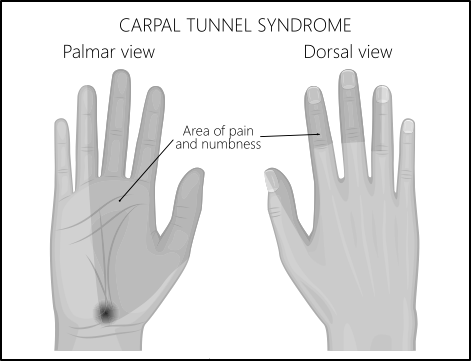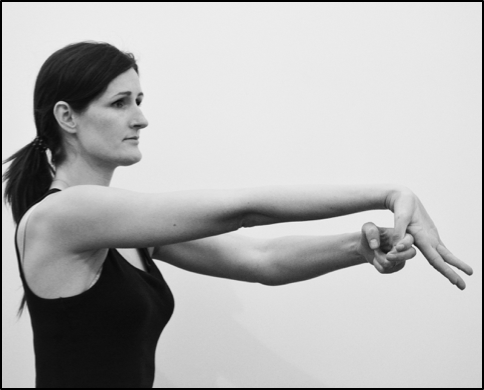If you’re experiencing a tingling, numbness or pain in one or both hands you may have a condition called Carpal Tunnel Syndrome.
Carpal Tunnel Syndrome is quite common during pregnancy but it can affect anyone, at any age. It’s caused by compression of one of the nerves in your wrist and one of the key features is that your symptoms will have a clear ‘edge and aspect’. This means that symptoms will be located in a very specific part of your hand. So specific, in fact, that you could draw an imaginary line around it like this:
It’s also likely that your symptoms are worse at night. You may wake up with a dead sensation in your hand or intense pins and needles and often hanging your arm over the edge of your bed and shaking it brings back the normal feeling. Activities that involve gripping may also trigger your symptoms and as time progresses you may find that your hand feels a bit weaker or clumsier during intricate tasks.
Self-test for Carpal Tunnel Syndrome
Bend your wrists and stay in this position for 3 minutes.
If this test brings on your symptoms within 1-2 minutes, then it’s likely that you have Carpal Tunnel Syndrome.
How to relieve Carpal Tunnel Syndrome
Here are our four top tips for relieving the symptoms of Carpal Tunnel Syndrome:
1. Stretch out your wrist muscles:
With your elbow straight, bend your wrist back and use your other hand to gently help stretch.
Hold for 15 – 30 seconds and repeat 3 times.
2. Stretch your thumb muscles:
With your elbow straight, take hold of your thumb and gently draw it back to increase the stretch.
Hold for 15 – 30 seconds and repeat 3 times.

Amazing results and amazing physio...
“Amazing results and amazing physio. I was suffering with pain in my wrist and elbow that didn’t let me grab heavy objects, lift anything with my right hand and made work very painful. After 6 sessions with Rowan I do not suffer any more with pain. Highly recommended!”
Soraya Barrera
I would recommend these folks to anyone...
“The treatment is professional and evidence-based – what’s more I also always feel listened to and genuinely cared for. I was very nervous about the long term effects of my injury but don’t think I could have been in better hands. After initial treatment with Rowan for a lower back soft-tissue injury and now rehab/strengthening programme with Henri, I am back running/circuit training faster than before, what more can I say?”
Within weeks I was back to work pain free...
“Henri was extremely knowledgeable, professional, friendly and a pleasure to be around. Within weeks I was back to work pain free and back in the gym with a new training routine, new form and a new lease of life!!”
Adam Bell
Extremely knowledgeable and professional...
“Rowan was extremely knowledgeable and professional in her approach. I highly recommend Physiofit for anyone seeking physiotherapy services.”
Lowen Warrington

3. Glide the nerve as it travels from your neck to your wrist:
Make a fist and bend your wrist towards your shoulder on your bad side, side bend your head away. Then press your palm away and bend your head towards the bad side. Move within a comfort zone and repeat 15 times.
Tips: you might want to start with a slightly smaller range of movement and build up.
4. Wear a wrist splint at night:
Put your splint on before you go to bed and wear it through the night for 2 weeks. It can also be worn during the day for short periods if you are unable to avoid doing an activity that normally brings on your symptoms. Look for a splint which contains a shaped metal bar sitting along the palm side of your hand and forearm.
Other treatment options for Carpal Tunnel Syndrome
Your GP might recommend a steroid injection to reduce swelling and relieve compression on the nerve. It can give good short term relief of your symptoms but it’s vital that any underlying causes are addressed to prevent the condition from coming back.
If treatment hasn’t been effective, your GP can refer you for tests to see how fast your nerves are able to send electricals signal from one part to another (nerve conduction testing). If these tests show that your nerves are not working quickly enough you may be offered surgery to release the pressure at your wrist.
Although it is possible to have carpal tunnel in both hands at the same time it’s unusual. If you are experiencing your symptoms in both hands the problem may actually be coming from your neck. Either way we’d recommend a physical assessment with your GP or a physiotherapist.
If you think you might be suffering from Carpal Tunnel Syndrome and you’d like to speak to someone about your symptoms, please don’t hesitate to give us a call.
If you think we can help you, please get in touch.
Related Articles
February 27, 2024
What should I do if I sprain my knee?
February 6, 2024
How to prevent an injury at the gym
September 21, 2023
The benefits of weight training
March 12, 2021
How to start exercising after a long break
January 19, 2021












